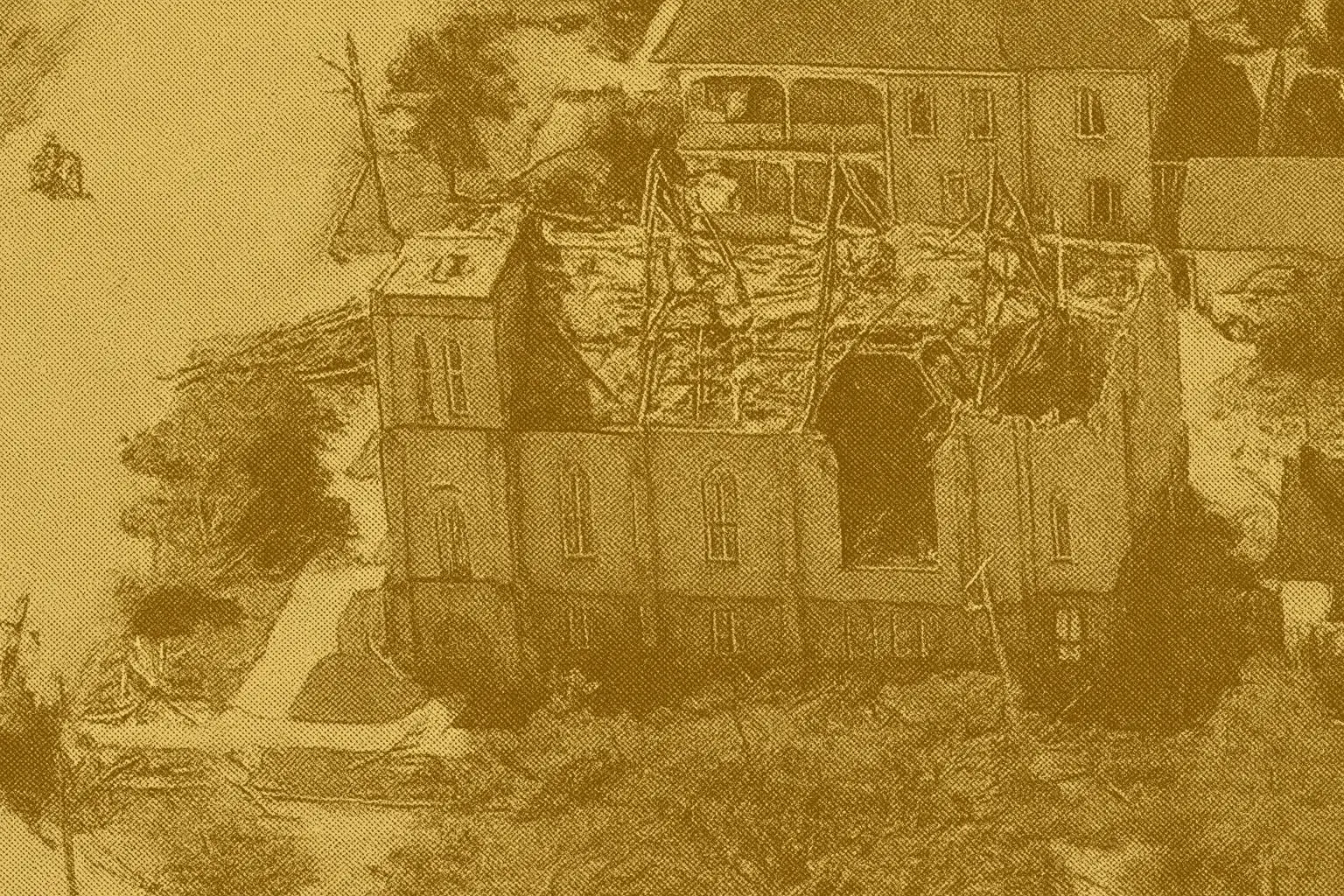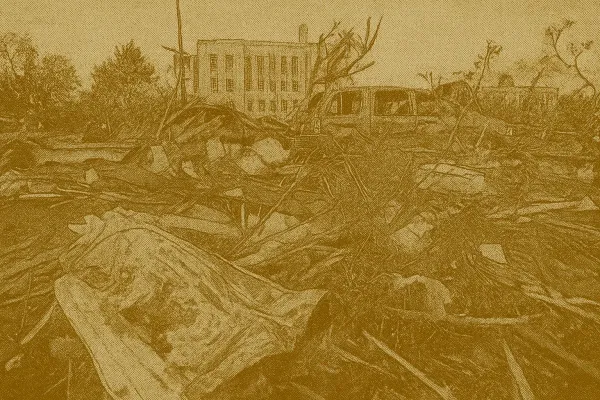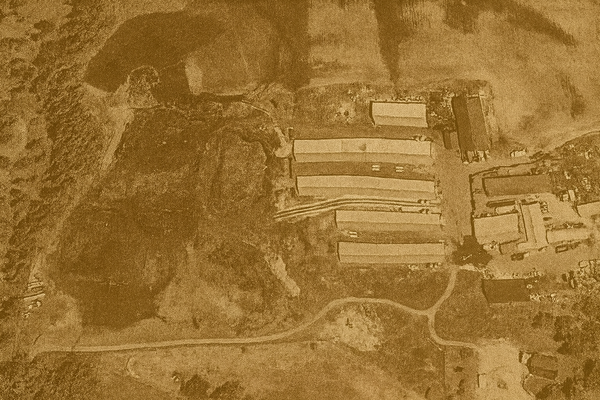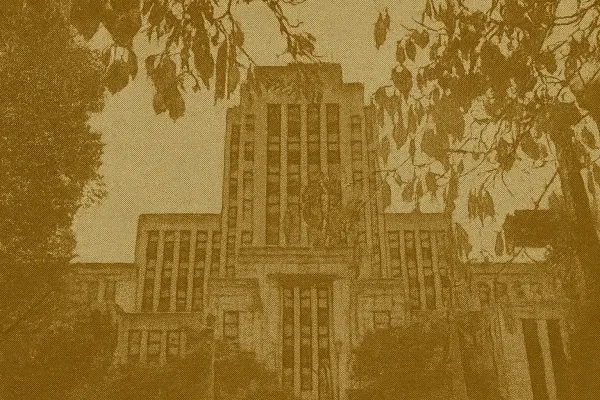This report is based on multiple sources, including news articles, public records, official documents, and community input. While every effort has been made to ensure accuracy, some details may be disputed or evolving. For corrections, please contact info@thecanadareport.ca.
The day Canada’s prettiest town went grey
At 3:55 in the afternoon on a late August Sunday, Goderich’s octagonal square, laid out in 1828 and framed by brick storefronts and a ring of towering maples, went dark. People described the sound later as a freight train, a roar that swallowed conversation and the familiar clang of the courthouse clock. The hail came first, golf ball to baseball sized, driven by a wind that lifted patio chairs and sent cafe signs cartwheeling into the street. In Coffee Culture on the Square, regulars pushed back from the windows as tiles popped from the floor and glass blew inward. In an upstairs flat at West Street and the Square, Tim and Ange Packham huddled as a bloodied family of four pounded on their door seeking shelter, their pickup truck now sitting on top of someone else’s car.

On the edge of town, a 61-year-old crane operator named Normand Laberge fought the wind as he tried to lower a ship-loading boom at the Sifto salt mine. The supercell that had bubbled up over northern Michigan and then re-intensified as it moved across Lake Huron landed its full force on Goderich’s harbour. A ship captain would later report his anemometer spiking to 150 knots as the storm passed. At the mine, the boom collapsed. Brenda Turcotte Laberge, his wife, said later that he always watched the sky, that he had reported seeing a bad storm on the horizon. “Within seconds, it was over,” she said. He did not make it out.
The tornado that tore into Goderich on August 21, 2011 was the strongest in Ontario in more than fifteen years, an F3 with winds estimated over 300 kilometres per hour. The way it presented was a cruel twist, rain-wrapped and thick with rotating curtains that masked the funnel. The only warning for many was the heaving of limbs from the maple canopy and a sound like heavy artillery pounding the side of houses. In thirty seconds, century-old façades crumbled, parapets toppled and tree trunks snapped like chalk. When the wind moved on toward Benmiller, Goderich’s heart was unrecognizable.
By dusk, the Ontario Provincial Police had closed every road into town. Gas leaks hissed from mains ripped by upended roots. Utility crews moved in with chainsaws, and then with horizontal grinders that chewed through debris at 100 truckloads an hour. The square was cordoned off with fencing and concrete barriers. But as the dust settled and the grief sharpened, another story formed in the conversations on porches and in council meetings. Goderich would not rebuild with anonymous modern boxes. People said they wanted their square back, not as a replica in a theme park, but as the living centre of a town that remembered what it had been. What happened next turned a disaster into an unlikely civic project, one that blended hidden modern reinforcements with visible 19th century charm.
A square drawn in 1828 meets a 21st century storm
Goderich’s downtown is a rarity, a planned octagon from which streets radiate, a design credited to John Galt and Canada Company surveyors in 1828. The courthouse sits at its centre, the green park around it shaded by old trees. For generations, the commercial blocks that ringed the square were a catalogue of Ontario small-town architecture: ornate brickwork, cast-iron columns, arched second-storey windows and cornices that threw afternoon shadows onto the sidewalks. Tourists came to shop at the farmers’ market, to linger on benches under the canopy and to admire a town that called itself, with a straight face and a sense of earned pride, Canada’s prettiest.
The meteorology of what followed stands out because it should not have happened there. Goderich sits in the lake shadow of Huron, a place where cool marine air often suppresses thunderstorms that spin up farther inland. The region’s tornado climatology shows few events, and the parameters forecasters normally consult on days like that one, from the Supercell Composite Parameter to the Energy-Helicity Index, flagged only minimal risk. Environment Canada had issued a severe thunderstorm watch earlier in the day. It was a Sunday in late summer, cloud cover and earlier storms having cleared out the markets on the square hour or two before the roaring began. On paper, it was not a day for a strong tornado to find an 1828 plan.
It formed anyway. According to a detailed post-event analysis by Environment Canada researcher David Sills, a strong upper-level jet placed its left exit region over southern Ontario, a pattern present in 85 percent of Canadian F3 or greater tornadoes. Boundaries from earlier storm outflows carved a baroclinic zone across Lake Huron. The Goderich supercell developed along that boundary and intensified as it moved just north of it, the kind of alignment that can support long-lived low-level rotation. Photographs show the tornado on the lake five to ten minutes before landfall. The Exeter radar lit up with a textbook hook echo. A marine tornado warning went out at 3:38 pm. At 3:48 pm, a tornado warning for Goderich and southern Huron County was issued. The thunderstorm, the bulletin warned, “will make landfall near Goodrich about 4 pm. This thunderstorm has a history of producing tornadoes.”
The storm that confounded the forecast
The mismatch between morning outlooks and afternoon violence did not reflect complacency among forecasters so much as a gap in tools and patterns. The day’s CAPE was not remarkable, but the arriving upper jet increased deep-layer shear. The cold front had already pushed east by midday, which normally lowers risk. Sills and colleagues later argued that the underestimation of risk stemmed from models that could not resolve the vorticity supplied by the day’s subtle boundaries, not from a failure to monitor. In other words, the storm was driven by mesoscale dynamics that exploited a Great Lake’s nuances.
To local eyes on the shoreline, nothing about the approach screamed tornado. The funnel was hidden inside rain. That ambiguity entitled spectators to doubt, even as the roar intensified. Some thought they were hearing a freighter’s engines. Others were lulled by the heavy rain’s cadence. Inside a house on East Street, a woman on her computer heard her dog go frantic, then watched softball-sized hail slam windows as if fired from a gun. In the KFC near the five points, observers watched the great Gothic roof of Victoria Street United Church collapse inward. There had been tornadoes elsewhere in Ontario earlier that day, a weak one near Gananoque at lunchtime, but the idea that one would claw its way in from the lake, onto the bluff, directly into the square, seemed unfairly cinematic.

This is not a complaint about science, it is a recognition that small towns situated along lakeshores are now being surprised by extreme events that split the difference between probabilities. The weather office did issue a warning, but people did not hear it. Huron County did not have a siren network. There were seconds, not minutes, to decide to run to a basement. Many were already in cars, heading home from Sunday outings. They became pinned against walls and imploded windows. A young man driving up South Street described glancing up, seeing blue sky in a brief calm at the storm’s centre and then understanding that the sky itself could be a trick.
Twelve minutes, no sirens
Environment Canada’s tornado warning for Goderich hit the wires twelve minutes before landfall. The bulletin’s language was clear: take cover, this storm has produced tornadoes, it is moving southeast at 75 kilometres an hour. Huron County had no tornado sirens. That absence is not unusual in Ontario, a province that relies on broadcast and digital alerts and, increasingly, mobile phone systems. In 2011, push alerts to phones were not yet standard. Radio warnings require people to be listening. The earlier thunderstorm that emptied the downtown of hundreds of market-goers may have saved lives by accident.
Afterward, the politics of warnings went from theoretical to urgent. County officials discussed sirens and asked for a government grant to purchase thirty units for communities across Huron. The request was denied. Clinton, a nearby community, repurposed its volunteer fire department’s siren for severe weather. Others explored using Cold War air raid sirens. It is an awkward conversation, because sirens do not stop storms and can be expensive to maintain. But in the minutes that separate inconvenience from terror, noise matters. A siren is a blunt instrument that buys seconds.
Support The Canada Report and help keep it ad-free and independent — click here before you shop online . We may receive a small commission if you make a purchase. Your support means a lot — thank you.
The widow of the only person killed that day wanted to know the why inside the how. “Why was he the only one,” Brenda Turcotte Laberge asked in a CBC interview two days after the storm. Company officials said the mine was being evacuated, that the majority of employees were underground and that the loader operator’s position above ground made him more vulnerable. The plausibility of that explanation does not mute the question. Twelve minutes is both a gift and a torment. It is enough to know, not always enough to move.
The first 72 hours of chaos and control
In the hours after the wind, Goderich declared a state of emergency. The Emergency Control Group convened a first meeting within three hours of the strike. The command centre moved to the rec complex, which kept power when 40 percent of the grid came back on the first night. Within two weeks, electricity returned to all but the most damaged buildings. That speed hid drama. The utility’s operations centre had been destroyed, trapping vehicles. Substation #2 took a hit. One hundred poles had to be replaced, twenty transformers were down and nearly five kilometres of line had to be rebuilt. Hydro reinforcements, fifty linemen plus equipment, arrived. A z-factor application to the Ontario Energy Board would later define the repair costs as an extraordinary event, but not one eligible for immediate pass-through to customers. The interim rate increase request was rejected. The losses were rolled into a cost-of-service case months later.
Related: Newfoundland Home Weatherproofing: The Ultimate Guide to Wind & Rain Protection
Natural gas could not be safely left on. The tornado’s root-under-root damage to mains forced Union Gas to shut off supply to the entire town, a choice that made natural gas generators temporarily useless. Fifty Union Gas workers swarmed in, and within two weeks everyone was reconnected. The OPP deployed 432 officers to cordon off the downtown and control access. There were 500 trees down on public lands, and sections of the cemetery were flattened. Heavy rains later that week piled misery on top of rubble. Ministry of Labour safety protocols and asbestos assessments, crucial for worker protection, slowed access in the heart of the zone for roughly three days.
On paper, the numbers feel clean. In the square and the neighbourhoods immediately northwest and east, the reality was shock. At the Waterloo and St. George’s Crescent area near the bluff, roofs were peeled back and flung aside. Upper floors were torn away, exposing lath and rooms to the sky. Bricks became projectiles that crushed parked cars and embedded themselves in tree trunks. Timber power poles snapped. Concrete light standards leaned at wrong angles. The Huron County courthouse, sturdy on its stone base, stood, but suffered major interior damage. The town fenced the entire perimeter of the square to protect what was left and to shield the work of retrieval and temporary repairs.
Rebuilding a time capsule
Town officials could have used the disaster to push a new aesthetic, cheaper, quicker, less exact. They did not. Goderich quietly rewrote its planning rules to allow destroyed structures to be rebuilt exactly on their footprints, even if they no longer conformed to modern zoning. The so-called Tornado Bylaw created a temporary exemption, paired with a Temporary Use Bylaw that allowed displaced businesses to open in locations that would otherwise be off-limits, including homes and highway commercial strips, for eighteen months. Council hired The Planning Partnership to produce a Downtown Core Master Plan and a Courthouse Park landscape design. A first public meeting on September 24 drew strong attendance. It was clear what people wanted: the square they knew.
What they got, over time, were façades that looked the same in photographs, built with the methods and codes of a new century. Behind the corbelled brickwork and restored cornices, builders inserted steel, improved anchorage and modern energy-efficient HVAC. Windows matched original proportions. The courthouse park, once stripped to dirt and stumps, became a construction site for a different kind of planting. Trucks arrived in a parade of trees. One hundred and seventy-six new trees were craned into the park over two months, a choreography that involved hand-digging massive root balls, using cranes to position oaks and elms and metasequoias and wiring irrigation systems. The spectacle drew TV cameras and neighbours who came to watch and to cheer. The landscape firm that sourced the trees reported a 95 percent survival rate the following spring.

The square added a new band shell. A water feature was installed using basalt columns. A statue appeared in front of the courthouse. The farmers’ market returned. A year after the storm, 152 of 170 downtown businesses had reopened. The last major commercial block to be finished, the Kingston Street stretch on the square, took longer. By 2015, the courthouse park was fully re-opened. In May 2016, a postgraduate researcher visiting from Wilfrid Laurier University called the downtown “absolutely gorgeous”, noting that the only visible tornado scars were fallen trees and cemetery debris. Behind the viewfinders, the upgrades were structural. Parapets that had failed under lateral wind loads were now tied back. In a town where heritage is often an act of memory, the rebuild made the memory load-bearing.
The price of preservation
Disaster recovery is a ledger, even when the first entries are names and injuries. The Insurance Bureau of Canada estimated insured losses at about $75 million. The mayor put the total bill at over $100 million. Other contemporary reports placed the range between $130 and $150 million. The exact figure depends on what you count and when you stop counting. The town’s preliminary estimate was $100 million in damage within its boundaries alone. Fifty-four buildings were demolished, nineteen commercial and thirty-five residential, with another 283 requiring repair. In public works budgets and utility books, the costs stacked up quickly.
Ontario’s Disaster Relief Assistance programme moved fast by government standards. The Premier arrived the next day and pledged up to $5 million, split between municipal recovery and assistance to private individuals, farms, small businesses and non-profits through a matching formula. A volunteer Goderich and Area Disaster Relief Committee was set up at arm’s length from town hall to administer claims and raise funds. By mid-2012, volunteers had raised more than $3.9 million. Early talk of a 2-to-1 provincial match suggested a pot over $12 million, but the final commitments were smaller. By February 2013, the committee had paid or committed roughly $6.2 million, with just over $4 million raised locally and about $2.16 million contributed by the province. The numbers are not an indictment, they reflect the friction of disaster aid formulas meeting the specifics of a town.
There were surprises that year. The hydro utility’s storm repairs, about $1.5 million in new capital and fixes, were not covered by insurance or by provincial or federal disaster programmes. The Ontario Energy Board agreed the storm was extraordinary but rejected an interim $4-per-month rate rider to recover costs. The utility had to embed losses in a later cost-of-service application. For a town of fewer than 8,000, these costs show up where people feel them, on monthly bills and tax notices. Other grant applications to federal and provincial infrastructure funds for core-area work were unsuccessful. That did not stop the rebuild, but it shaped timelines and tradeoffs.
Related: Car Emergency Kit Essentials for Every Driver in Canada
Voices from the path
Stories from that day sit in family archives. They are often told in the present tense because the body remembers without dates. A youth on South Street sees blue sky through the eye. A woman on East Street says she felt trapped in a suction tube as her neighbour’s roof lifted away. Kris Reilly, in a parking lot near Highway 21, watches the church’s roof fold into the nave and says, “the roof of the church is… gone, the trees are… gone.” Gary Johnston hears someone shout that a woman in the street has taken a two-by-four in the chest. In a house on Elgin Avenue, a mother grabs her 11-month-old and sprints for the basement, fighting a basement door sealed by pressure. “We couldn’t hear anything but the sound of a high-powered freight train and heavy artillery attacking the side of our home,” she recalls.
At the Smiths’ family reunion on Cambria Road, 31 relatives pile into a back hall and throw blankets over children as the storm passes. When they emerge, the trees are down and the porch is littered with glass. At the carwash beside the church, a man on a motorcycle breaks both legs when a wall collapses onto him, three others are cut by glass. The storm moves east-southeast, following the Maitland River’s bend, and someone in Benmiller swears the tornado made the river run backwards for a few seconds. The Benmiller Inn, a fixture of the area’s rural hospitality, is battered. The storm finally dissipates in open fields near Londesborough, its path having widened in the countryside and narrowed over the square as if with intent.
Media showed up. Photographs of the square’s ring of voids and broken brick ran across the country. Environment Canada later listed the event in its top ten Canadian weather stories for 2011. A book, Not Like Any Other Sunday, was published to capture the day and to raise money for recovery, with proceeds directed to victim services and tree replanting. The coverage framed the town as an emblem of small-town vulnerability and resilience. That is true, and yet skins over a rougher texture of grief and argument that always attends recovery.
Patterns and rising risks
It matters that Goderich is a lake town. It matters that the tornado developed over water, well behind a cold front, in a place where lake-breeze dynamics usually suppress storms. Climate signals are not destiny for any one day, but warming lakes, changing jet structures and a convective season that now stretches beyond what people remember are reshaping risk envelopes. The Sills paper’s recommendations are mundane and radical at once: better real-time tools to monitor boundaries, nowcasting that bakes in boundary-driven vorticity, and forecast indices that account for the spin that outflow collisions can inject into the lowest kilometre of the atmosphere.
On the ground, small towns face choices about alarms and redundancy. The denial of Huron County’s siren grant left communities to jury-rig solutions. In 2011, smartphone alerts were not ubiquitous. They are now. But warnings are only one layer. The real work is in building stock. Heritage districts make for beautiful streetscapes that also include unreinforced masonry and parapets that can behave badly under lateral loads. Goderich’s rebuild shows that it is possible to preserve the surface while changing the physics behind it, anchoring walls, bracing parapets, inserting steel and meeting energy codes that reduce the building’s everyday emissions. This is not cosmetic. It is adaptation.
Support The Canada Report and help keep it ad-free and independent — click here before you shop online . We may receive a small commission if you make a purchase. Your support means a lot — thank you.
Accountability, from sirens to ship loaders
Responsibility is always plural after a storm. Environment Canada’s forecasters acted with what tools they had, issued a watch and then a warning in time for some, not for all. Local officials had no siren network to trigger. The county would later ask for funding for thirty sirens and be turned down. That is a policy choice that should sit beside the charts. The salt company said it had begun an evacuation, that the worker who died could not get out in time. His widow’s questions echo in that space between intention and outcome. The Ministry of Labour’s insistence on safety protocols during cleanup likely saved other lives even as it slowed access to the core.
The town’s planning choices are the other side of accountability. They were deliberate and community-led. Temporary bylaws opened a path back for the square’s businesses. But the argument about heritage and modernization did not go away, it was reconfigured. Why rebuild as it was, critics asked, when stronger concrete or different setbacks might reduce vulnerability? The town’s answer was layered: keep the visible history, hide the upgrades, and use the rebuild to bring electrical, mechanical and structural systems to modern standards. That compromise, a kind of civic palimpsest, is now part of the Goderich model.
The blueprint, and the bill, for the next storm
If you walk the square now, the scars do not announce themselves. You see brick and cornices and shop windows that match the photos. You hear the band at the new shell. You sit under young trees that were planted as an act of defiance against a sky that had taken so many. The water feature burbles in front of the courthouse, placed where stump holes once made a grid. If you listen, the people of the town will tell you that the tornado changed them in ways that do not show as easily. There is a store of muscle memory for heavy weather. There is an understanding of how quickly funds can flow and how they can jam in the valves of eligibility.
There is also a cautionary ledger. Public appeals raised $4 million. The province’s matching did not reach the dreamed-of heights. Hydro costs landed, eventually, on ratepayers. Federal and provincial infrastructure grants were denied for core projects, leaving local taxpayers to carry a larger share. Yet within a year, most downtown businesses were open. Five years on, a visiting researcher found an “absolutely gorgeous” centre that hid the facts of steel and code upgrades in its bones. Some heritage structures were too damaged to save and were razed in October of that year, including an opera house on Kingston Street, a church on Victoria Street and a studio on Montreal Street. Memory and loss live side by side.
Small towns across Canada watch these stories for hints about their own future. The mix here matters. A plan drawn in 1828 cannot absorb a 21st century storm without help, but a community can decide that its plan is worth the engineering. Goderich’s decision to rebuild the way it remembered itself, with the guts of modern safety and efficiency, offers a blueprint that other towns might adapt. It suggests that emergency management that can move decisions into hours, not days, will save not just lives but civic identity. It also shines a light on policy gaps, like warning systems and utility-cost recovery, that make recovery uneven even when the will is strong.
What is left a decade later is not complacency. It is a practiced vigilance that remembers the freight train and the hail. It is the sound of a siren in Clinton and the glow of a phone alert in the middle of the night. It is the hum of a new HVAC system behind a restored storefront, the weight of a reinforced parapet above a sidewalk where the farmers’ market sets up on Saturday mornings. It is grief that asks for answers and resists easy ones. It is a square that has been through something and wears it lightly, a place where the past and the future share a block, and where the colour of the bricks is the same as it ever was, even if the steel behind them tells a story that begins with a summer afternoon when the sky turned strange and the wind came out of the lake.
Source 1 | Source 2 | Source 3 | Source 4 | Source 5 | Source 6 | Source 7 | Source 8 | Source 9








